Botia almorhae
Yo-Yo Loach
SynonymsTop ↑
Botia grandis Gray, 1832; Schistura maculata M’Clelland, 1839 (unnecessary replacement name for Botia grandis Gray, 1832)
Etymology
Named for Almora district, Uttarakhand State, India, type locality of this species.
Classification
Order: Cypriniformes Family: Botiidae
Distribution
B. almorhae appears to belong to a group of closely-related, but distinct, species. Following Grant (2007) these are:
B. almorhae Gray, 1831 – This species is often referred to as the ‘Pakistani’ loach which is a misnomer since it’s restricted to parts of the Ganges River drainage in northern India and possibly Nepal.
The description by Gray (1831) gives the type locality simply as ‘Almorah’ which corresponds to Almora district, Uttarakhand State, India and means the holotype could have derived from either the Kosi River or Sot River (Grant, 2007).
In the Kosi drainage it’s been collected close to the cities of Roorkee and Kashipur (both Uttarakhand State) and has also been recorded from the Yamuna River (Delhi State), Alaknanda River (Uttarakhand State), Markanda River (tributary of the Yamuna in Himachal Pradesh and Haryana States), Ghugger River (Himachal Pradesh State), Kali River (near the city of Meerut and in Muzaffarnagar and Bijnour districts, Uttar Pradesh State), Gambhir River (Sawai Madhopur district, Rajasthan State) and Chambal River (Kota district, Rajasthan State).
Grant (2007) notes that the Chambal population is in need of study to confirm whether it’s B. almorhae or something else.
B. birdi Chaudhuri, 1909 – This species and B. lohacata are included here as we’ve been unable to obtain any images of confirmed specimens to date.
It’s also the species that can accurately be referred to as ‘Pakistani’ loach since it’s native to the Indus River drainage in Pakistan and northern India.
In Pakistan it’s been recorded from tributaries along much of the river‘s course including the Kabul and Jove rivers, North-West Frontier Province; at various locations in Punjab Province (probably including the Beas and Sutlej Rivers); Balochistan Province (multiple reports but we’re unable to provide details at present); near the city of Sanghar, Sindah Province.
A second species from Pakistan, B. javedi, was described in 1995 from the Kabul river close to the city of Peshawar but is currently considered synonymous with B. birdi (questionably so according to Kottelat, 2004).
Indian localities include the Indus tributaries Jhelam River in Jammu and Kashmir state; the Sutlej River, Punjab state; near Kangra town, Himachal Pradesh state (almost certainly the Beas River, a tributary of the Sutlej); possibly the Tawi River, a tributary of the Chenab River in Jammu and Kashmir.
B. lohachata Chaudhuri, 1912 – This species is another to have been referred to as ‘Pakistani’ loach in the past but all known records allude to the Ganges drainage in India and Nepal.
In the former it’s known from various localities in Bihar state including the Gandak, Jamwari, Balkhau and Shalkia plus the Rapti and Rohini rivers in the Gorakhpur district of neighbouring Uttar Pradesh state.
In Nepal records include the Kali Gandaki/Narayani (known as the Gandak in India), Rapti and Bagmati river drainages and the nature reserves of Bardia and Shukla Phanta.
Grant (2007) notes that populations from the Karnali/Ghaghara River in Seti Zone, Nepal and the Gomti River in Uttar Pradesh state, India require further study to ascertain whether they’re conspecific with B. lohachata or represent other taxa. It’s validity is in question but nominally accepted at present.
B. sp. ‘Kosi’ – Known from the Kosi River in Nepal; the Hooghly River near Kolkata, West Bengal District, India; possibly from Dhaka and Rajshahi Divisions, Bangladesh. This may be a form of B. almorhae but appears different in some respects.
B. sp. ‘Teesta’ – To date recorded only from the Teesta/Tista River in West Bengal state, India (part of the Brahmaputra drainage). Again it may turn out to be a variant of B. almorhae.
Habitat
A riverine species tending to congregate in pools and stiller areas characterised by rocky substrates. It undergoes upstream migrations prior to spawning.
Maximum Standard Length
140 – 160 mm.
Aquarium SizeTop ↑
Base dimensions of 120 ∗ 45 cm or equivalent should be the minimum considered.
Maintenance
All botiids need a well-structured set-up although the actual choice of décor is more-or-less down to personal taste.
A natural-style arrangement could include a substrate of sand or fine gravel with lots of smooth, water-worn rocks and pebbles plus driftwood roots and branches.
Lighting can be relatively subdued and plants able to grow in such conditions like Microsorum pteropus (Java fern), Taxiphyllum barbieri (‘Java’ moss) or Anubias spp. can be added if you wish. These have an added benefit as they can be attached to pieces of décor in such a way as to provide useful shade.
Otherwise be sure to provide plenty of cover as botiids are inquisitive and seems to enjoy exploring their surroundings. Rocks, wood, flower pots and aquarium ornaments can be used in whichever combination to achieve the desired effect.
Bear in mind that they like to squeeze themselves into small gaps and crevices so items with sharp edges should be omitted, and any gaps or holes small enough for a fish to become trapped should be filled in with aquarium-grade silicone sealant. A tightly-fitting cover is also essential as these loaches do jump at times.
Although botiids don’t require turbulent conditions they do best when the water is well-oxygenated with a degree of flow, are intolerant to accumulation of organic wastes and requires spotless water in order to thrive.
For these reasons they should never be introduced to biologically immature set-ups and adapt most readily to stable, mature aquaria. In terms of maintenance weekly water changes of 30-50% tank volume should be considered routine.
Water Conditions
Temperature: 19 – 27.5 °C. Almost certainly experiences cooler temperatures at certain times of year in nature but for aquarium maintenance somewhere around the middle of this range should suffice.
pH: 6.0 – 7.5
Hardness: 36 – 215 ppm
Diet
While Botia spp. appear to be chiefly carnivorous they will also eat vegetative matter if available, often including soft-leaved aquatic plants. The natural diet comprises aquatic molluscs, insects, worms, and other invertebrates.
They’re largely unfussy feeders but must be offered a varied diet comprising quality dried products, live or frozen bloodworm, Tubifex, Artemia, etc., plus fresh fruit and vegetables such as cucumber, melon, blanched spinach, or courgette.
Home-made foods using a mixture of natural ingredients and bound with gelatin are also highly recommended.
Chopped earthworm can also provide a useful source of protein but should be used sparingly, and while most botiids also prey on aquatic snails though should never be considered the answer to an infestation since they’re not obligate molluscivores.
Once settled into an aquarium they’re bold feeders and often rise into midwater at meal times.
Behaviour and CompatibilityTop ↑
Not especially aggressive but much smaller fishes may be intimidated by its size and sometimes very active behaviour. Slow-moving, long-finned species such as ornamental bettas, guppies and many cichlids should also be avoided as trailing fins can be nipped.
More suitable tankmates include peaceful, open water-dwelling cyprinids, while in larger tanks members of Barilius, Luciosoma, Balantiocheilos and Barbonymus become options.
In terms of other bottom-dwellers they will do well alongside most other Botia and in very large tanks, Chromobotia macracanthus.
Some cobitid and nemacheilid loaches are also possibilities as are members of Epalzeorhynchos, Crossocheilus and Garra and many catfishes.
As always, thorough research prior to selecting a community of fishes is the best way to avoid problems.
Botia spp. are gregarious, form complex social hierarchies and should be maintained in groups of at least 5 or 6 specimens, preferably 10 or more.
When kept singly they can become withdrawn or aggressive towards similarly-shaped fishes, and if only a pair or trio are purchased the dominant individual may stress the other(s) to the extent that they stop feeding.
B. almorhae group members tend to form less tightly-knit aggregations than some congeners but should still be kept in numbers since they require regular contact with conspecifics, a fact exemplied by a number of behavioural rituals which have been recorded consistently in aquaria (see ‘Notes’).
Sexual Dimorphism
Sexually mature females are normally fuller-bodied than males.
Reproduction
No reports of breeding in private aquaria but some species are mass-produced for the hobby via the use of hormones.
Unfortunately this practice has been taken to a different level in recent years with a number of hybrids appearing on the market, even including an apparent cross between a form of B. histrionica and Chromobotia macracanthus.
NotesTop ↑
The physical appearance of B. almorhae sensu stricto is something of a mystery. No pictures of live specimens appear in any scientific publications we’ve read and we’ve been unable to find a certified image of one anywhere meaning it’s possibly never been seen in the aquarium trade.
Instead the most commonly available members of the nominal species grouping seem to be B. lohachata, B. sp. ‘Kosi’ and B. sp. ‘Teesta’ (see individual notes below), plus the assorted hybrids that have appeared since the turn of the century (Grant, 2007).
The most commonly-used vernacular name of ‘yo-yo’ loach is derived from the typical body patterning in juveniles of the group, comprising a series of alternating ‘i’ and ‘y’ shaped black, grey or brown bars (usually 4-5 of the former, 3 of the latter) which in most specimens appears to form that phrase if one imagines the ‘i’ bars to form the centre of each ‘o’.
As the fish age the bars break up in a process sometimes referred to as anastomosis. B. almorhae group members are further told apart from other Botia spp. by a base body colour of ‘whitish, yellow, golden, or very light green’ and relatively large adult size of up to 160 mm SL (Grant, 2007).
B. almorhae – The description of this species is very brief and it was not until a year after publication that Gray published a drawing of the holotype with the now synonymous name B. grandi.
It’s often been confused with B. birdi and B. lohachata and the latter has been considered a junior synonym by some authors.
Body colouration in juveniles is yellowish with brown ‘i’ and ‘y’ markings with 1-3 bands in the dorsal–fin. As the fish age the number of bands in both pectoral and dorsal fins increases and the ‘i’ and ‘y’ markings anastomose resulting in a series of highly variable yellow spots. In some adults part of the ‘i’ and ‘y’ patterning can remain but this does not appear related to gender (Grant, 2007).
B. birdi – Juvenile colouration is yellow to beige with brown to black ‘i’ and ‘y’ markings, whereas in adults the lower portion of the body is yellowish white and the upper darker. The ‘i’ and ‘y’ bars do not reach the ventral surface, anastomose up in some specimens and in very large adults can be absent altogether.
The pectoral, anal and ventral fins contain either no markings or 2-3 bands; the dorsal–fin has 2-3 brown to black bands and the caudal 3-4. Chaudhuri (1909) states that the snout in his specimens was reddish post-capture.
This species is very similar in appearance to B. almorhae and Grant (2007) found the only discernible differences to be colour pattern, distribution and the number of vertebrae (27-30 in B. almorhae vs. 30-31 in B. birdi but considered this sufficient to maintain their status as distinct species in the absence of genetic studies.
Although the Indus and Ganges drainages are separated now it’s thought the Yamuna River connected the two as little as 4000 years ago so this may explain these species‘ similarity.
At any rate you’re unlikely to see B. birdi on sale given the lack of commercial fish collections in its native rivers and again, verified images of live specimens are almost unheard of.
B. lohachata – The validity of this species has never been fully resolved since it was described using just a single juvenile specimen. Young fish exhibit a gold to silver metallic sheen while adult body is grey to green without sheen. There are typically 3 ‘y’ markings which anastomose or remain unconnected in some individuals of all ages.
The dorsal–fin has 2 or 3 bands (usually 3), the caudal 3-4, the anal 1-2 (usually 1), the ventrals 1-4 (usually increasing in number with age) and the pectoral fins usually 3. Grant (2007) considers it distinct but stresses that confirmation is required, and we think this form definitely has been exported for the aquarium trade.
B. sp. ‘Kosi’- This potentially undescribed species tends to possess paler base body colouration and a reduced body depth compared to length than B. almorhae and B. lohachata.
Grant (2007) hypothesises that it may be undescribed since work by Ng and Edds in 2005 proved that catfishes inhabiting different rivers in Nepal (e.g., the Kosi, Narayani, Seti, Ghomti, etc.) and previously considered to represent the same species are in fact different. B. sp. ‘Kosi’ is available in the trade on an occasional basis.
B. sp. ‘Teesta’- Grant (2007) considers this an undescribed species based on it’s distribution (Brahmaputra, as opposed to Ganges river basin) and the fact it differs slightly in patterning compared with B. almorhae. This one has also been seen in the hobby.
As currently recognised the distribution of the genus Botia extends eastwards from the Indus River basin in Pakistan across northern India, then southwards through Myanmar as far as the Salween drainage (Ataran River). This range was previously much larger but modern studies have resulted in various changes to the taxonomy of both family and genus.
The latter is currently defined by the following combination of characters, as given by Kottelat (2004): mental lobe developed in a barbel; fronto-parietal fontanelle narrow; anterior chamber of gas bladder almost entirely covered by bony capsule, posterior chamber large or rather reduced; anterior process of premaxilla entire, not surrounding a cavity; rostral process rather long, with a more or less distinct ridge along inner edge; top of supraethmoid narrow or broad; optic foramen very small; suborbital spine not strongly curved backwards and bifid; head naked.
The family Botiidae has been widely considered a genetically distinct grouping since Nalbant (2002), having previously been considered a subfamily (Botiinae) of the family Cobitidae. Nalbant also moved some previous members of Botia into the new genus Yasuhikotakia based on a number of morphological characters.
Later Kottelat (2004) made further modifications to the taxonomy, raising Chromobotia for B. macracanthus and confirming that species previously included in the genus Hymenophysa should instead be referred to Syncrossus.
The former alteration was based on colour pattern plus some morphological characters and the latter because Hymenophysa not only represents a spelling mistake (McClelland’s original spelling was Hymenphysa) but is a junior synonym of Botia.
More recently Kottelat (2012) erected the genus Ambastaia to accommodate A.nigrolineata and A. sidthimunki, two former members of both Botia and Yasuhikotakia.
As a result of these works the family Botiidae is thus divided into two tribes within which Botia appears to be the most basal lineage:
Tribe Leptobotiini – Leptobotia, Parabotia, Sinibotia.
Tribe Botiini – Ambastaia, Botia, Chromobotia, Syncrossus, Yasuhikotakia.
Phylogenetic studies by Tang et al. (2005) and Šlechtová et al. (2006) have largely confirmed this system to be correct although the latter disagreed with the placement of Sinibotia, finding it to be more closely related to the tribe Botiini.
Ambastaia nigrolineata and A. sidthimunki were found to be more closely-related to both Sinibotia and Syncrossus than Yasuhikotakia, despite being considered members of the latter at the time. Šlechtová et al. also proposed the use of subfamily names under the following system:
Subfamily Leptobotiinae – Leptobotia, Parabotia.
Subfamily Botiinae – Botia, Chromobotia, Sinibotia, Syncrossus, Yasuhikotakia.
Within these Botia appears to be the basal, i.e., most ancient, lineage and in a more-detailed phylogenetic analysis Šlechtová et al. (2007) confirmed the validity of the family Botiidae with the genera listed above as members rather then being grouped into subfamilies. This more recent, simpler system is the one we currently follow here on SF.
Some behavioural routines exhibited by Botia spp. have been recorded often enough that they’ve been assigned non-scientific terms for ease of reference.
For example during dominance battles (these occur most frequently when the fish have been introduced to a new tank, or new individuals added to an existing group) the protagonists normally lose much of their body patterning and colouration, a phenomenon that’s come to be known as ‘greying out’.
Such displays will sometimes also happen within an established group as individuals seek to improve social ranking but are usually nothing to worry about.
Interestingly some observations suggest that the character of the highest-ranked, or alpha, fish appears to affect that of the whole group though it must be said that scientific studies of botiid loach behaviour are virtually non-existent.
It certainly seems that they display a degree of ‘personality’ with some specimens being naturally bolder or more aggressive than others, for example. The alpha is normally the largest specimen within the group and often female.
‘Shadowing’ is an interesting behaviour in which younger individuals swim flank-to-flank with older, mimicking their every movement. Some keepers report that more than one smaller fish may shadow a larger simultaneously, with even three or four on each side!
The reason for it is unknown; it may relate to a group staying in touch with one another when rivers swell during times of flooding, perhaps reducing drag by swimming ‘in formation’ or having some other communicative function.
It’s been observed in aquaria with both high and low water flow and seems to be habitual to the extent whereby some individuals will shadow other fishes if no conspecifics are present.
Sound also appears to be an important factor in communication since these loaches are able to produce audible clicking sounds, these increasing in volume when the fish are excited. The behavioural aspects of this phenomenon remain largely unstudied but the sounds are thought to be produced by grinding of the pharyngeal (throat) teeth or subocular spines.
A further curiosity is the so-called ‘loachy dance’ which involves an entire group swimming in a constant, restless fashion around the sides of the tank, usually utilising the full length and height.
The reasons for this are unknown and reports as to when it occurs vary but the most common triggers appear to be the addition of food, fresh water or new conspecifics, and it can last anything from a few minutes to a day or more.
Botiids also often settle at peculiar angles, wedged vertically or sideways between items of décor, or even lying flat on the substrate. This is no cause for alarm and appears to be a natural resting behaviour.
Botia spp. also possess sharp, motile, sub-ocular spines which are normally concealed within a pouch of skin but erected when an individual is stressed, e.g., if removed from the water. Care is therefore necessary as these can become entangled in aquarium nets and those of larger specimens can break human skin.
Botiids are also susceptible to a condition commonly referred to as ‘skinny disease’ and characterised by a loss of weight. This is especially common in newly-imported specimens and is thought to be caused by a species of the flagellate genus Spironucleus.
It’s treatable although the recommended medication varies depending on country. Hobbyists in the UK tend to use the antibiotic Levamisole and those in the United States Fenbendazole (aka Panacur).
References
- Chaudhuri, B. L., 1912 - Records of the Indian Museum (Calcutta) 7(5): 437-444
Descriptions of some new species of freshwater fishes from north India. - Grant, S., 2007 - Ichthyofile Number 2: 1-106
Fishes of the genus Botia Gray, 1831, in the Indian region (Teleostei: Botiidae). - Kottelat, M., 2004 - Zootaxa 401: 1-18
Botia kubotai, a new species of loach (Teleostei: Cobitidae) from the Ataran River basin (Myanmar), with comments on botiinae nomenclature and diagnosis of a new genus. - Kottelat, M., 2012 - Raffles Bulletin of Zoology Supplement 26: 1-199
Conspectus cobitidum: an inventory of the loaches of the world (Teleostei: Cypriniformes: Cobitoidei). - Nalbant, T. T., 2002 - Travaux du Museum d'Histoire Naturelle 'Grigore Antipa' 44: 309-333
Sixty million years of evolution. Part one: family Botiidae (Pisces: Ostariophysi: Cobitoidea). - Nalbant, T. T., 2004 - Travaux du Museum d'Histoire Naturelle 'Grigore Antipa' 47: 269-277
Hymenphysa, Hymenophysa, Syncrossus, Chromobotia and other problems in the systematics of Botiidae. A reply to Maurice Kottelat. - Ng, H. H., 2007 - Zootaxa 1608: 41-49
Botia udomritthiruji, a new species of botiid loach from southern Myanmar (Teleostei: Botiidae). - Tang, Q., B. Xiong, X. Yang and H. Liu, 2005 - Hydrobiologia 544(1): 249-258
Phylogeny of the East Asian botiine loaches (Cypriniformes, Botiidae) inferred from mitochondrial cytochrome b gene sequences. - Tang, Q., H. Liu, R. Mayden and B. Xiong, 2006 - Molecular Phylogenetics and Evolution 39(2): 347-357
Comparison of evolutionary rates in the mitochondrial DNA cytochrome b gene and control region and their implications for phylogeny of the Cobitoidea (Teleostei: Cypriniformes). - Šlechtová, V., J. Bohlen and H. H. Tan, 2007 - Molecular Phylogenetics and Evolution 44(3): 1358-1365
Families of Cobitoidea (Teleostei; Cypriniformes) as revealed from nuclear genetic data and the position of the mysterious genera Barbucca, Psilorhynchus, Serpenticobitis and Vaillantella. - Šlechtová, V., J. Bohlen, J. Freyhof and P. Ráb, 2006 - Molecular Phylogenetics and Evolution 39(2): 529-541
Molecular phylogeny of the Southeast Asian freshwater fish family Botiidae (Teleostei: Cobitoidea) and the origin of polyploidy in their evolution.
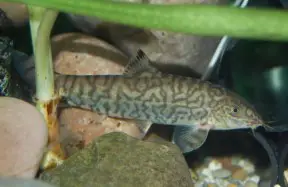


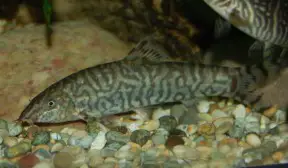

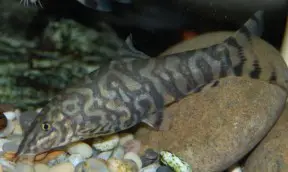
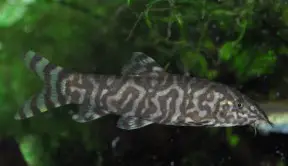






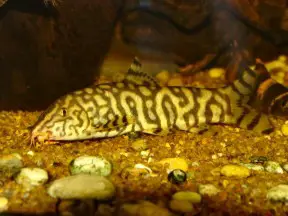


September 28th, 2014 at 11:32 am
The pictures for this look wrong to me. Should it not have distinctive marking that look like the letters Y-O?
September 29th, 2014 at 2:47 pm
Hi PA, only young specimens tend to display this pattern, and currently all our images depict adults.